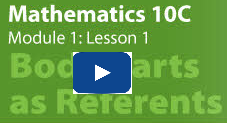Lesson 1: Systems of Measurement and Personal Referents
Discover
Go through the Referents Table, which introduces the idea of using referents. For example, you may discover that the thickness of 10 sheets of paper is a good approximation of 1 mm.
REFERENTS TABLE
|
Referent |
Description |
Example |
|
Millimetre |
The millimetre is 1/1000th of a metre. The millimetre is roughly the thickness of a dime. You can also think of 1 mm as the thickness of 10 sheets of paper. |
|
|
Centimetre |
The centimetre is 1/100th of a metre. The centimetre is approximately the thickness of 10 dimes. The centimetre can also be thought of as the width of the fingernail on your smallest finger. |
|
|
Metre |
One metre is the same as the height of a small child. One metre could also be the length of a running stride. |
PhotoObjects.net/Thinkstock |
|
Kilometre |
One kilometre is equal to 1000 m. You can think of 1 km as the length of 7 football fields. Another way to think about 1 km is the distance you can walk in 10 minutes. |
|
|
Inch |
One inch is an imperial unit. It can be approximated by the width of your thumbnail. |
Mark Poprocki/iStockphoto/Thinkstock |
|
Foot |
A foot is equal to 12 inches. There’s no better referent for a foot than your own foot! The foot can also be approximated by the length from your wrist to your elbow. Another convenient referent for 1 ft is the length of a 30-cm ruler. This is one of the most accurate estimations of 1 ft. |
|
|
Yard |
One yard is equal to 3 ft or 36 in. One referent for 1 yd is the width of a doorway. You can also think of 1 yd as the length of a normal walking stride. |
© Zdenek Krchak /shutterstock |
|
Mile |
One mile is equal to 1760 yards or 5280 feet. One mile is the distance of 15 to 20 city blocks. Another way to think of 1 mile is the distance the average person can jog in 10 minutes. |
© Laurens Parsons Photography/shutterstock |
Every person’s body is different. The length of your foot is most likely different from that of a classmate. In this lab you will determine the measurements of your body parts described in a chart in order to use the body parts as referents for measurement.
The multimedia piece “Body Parts as Referents” demonstrates the way body parts can be used as referents.
----------------------------------------------------------------------
![]() Math Lab: Body Referents
Math Lab: Body Referents
Complete Math Lab: Body Referents activity below.
Complete the table below by measuring each body part described in the chart. Record your measurements in both centimetres (SI units) and inches (imperial units).You may want to work with a classmate or a family member.

Procedure
You are now going to use the information gathered in the videos and the Math Lab to complete the following steps.
Step 1: Estimate the length of your desk or your kitchen table using one of the referents discussed in the videos and the Math Lab. Record the referent you used (e.g., thumbnail, foot, cubit) and your estimates, both in SI units and imperial units, in the following table.

Step 2: Repeat Step 1 for each of the following lengths or heights and distances:
- height of a wall
- length of an object that you can hold in your hand, such as your calculator
- distance from one corner of the room to the opposite corner
- perimeter of the classroom or other room
Step 3: Now measure each of the lengths, heights, and distances using a tape measure or ruler so that you can compare the results to your estimated values.
Analysis
Answer the following the questions in your course folder ( binder).
1. How close were your estimated values to the measured values?
2. What strategy could you use to make your estimation better?3. What benefits are there when you measure using referents?
4. What drawbacks are there when you measure using referents?![]() Share
Share
You now have an opportunity to share, with other students ( if possible), the answers to Math Lab: Body Referents questions you have just completed.
To make the most of this sharing opportunity you need to do the following:
- Ensure you have completed all the questions to the best of your ability and place them in a form that is convenient for sharing.
- Share your solutions with a classmate or other appropriate partner ( if possible).
- Review the results you recorded for steps 1 to 3. Are the results of other students similar to yours? Can you explain reasons for any differences?
- Review the answers provided to questions 1 and 2. If possible, discuss the answers to these questions with your partner. Your discussion might focus on clarifying meaning, or developing a clearer understanding of other students’ strategies and ideas.
- Finally, if necessary, revise your answers for questions 3 and 4 to incorporate what you have learned from the sharing you have done. Save a copy of your revised work in your course folder ( binder), along with a record of your discussion.








